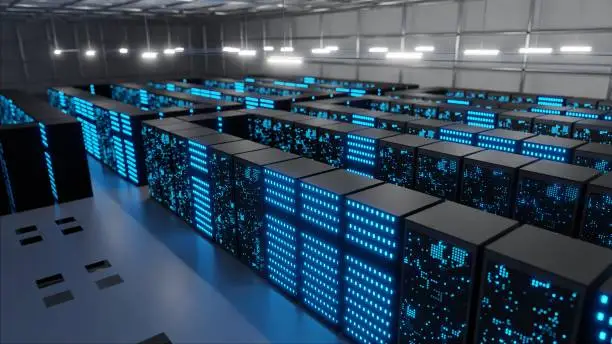How To Build A Supercomputer? Building a supercomputer is an ambitious project that requires a blend of technical prowess, strategic planning, and an understanding of high-performance computing (HPC) architecture. These machines, designed to perform computations at speeds far exceeding conventional systems, are essential for tackling complex problems in various domains, including scientific research, engineering, artificial intelligence, and cryptography. Supercomputers have reshaped how we approach data-intensive tasks, processing trillions or even quadrillions of calculations per second.
The journey to construct a supercomputer involves selecting specialized hardware like high-core-count CPUs and GPUs, configuring advanced cooling systems, and optimizing parallel processing frameworks for seamless operation. With unparalleled capabilities, supercomputers enable breakthroughs in climate modeling, genetic research, Artificial intelligence training, and national security. This guide offers a comprehensive, step-by-step approach to how to build a supercomputer, delving into its architecture, key components, applications, and the significant impact it has on advancing technology and solving some of the world’s most complex challenges.
What Defines a Supercomputer?
A supercomputer is a specialized computing system capable of performing highly complex calculations at speeds far beyond the reach of conventional computers. The hallmark of a supercomputer is its capacity for massive parallel processing, allowing it to handle trillions or even quadrillions of calculations per second. This performance is measured in FLOPS (floating-point operations per second).
Characteristics of Supercomputers
- Massive Parallelism: A supercomputer’s strength lies in its ability to process multiple tasks simultaneously across thousands or millions of processing cores.
- High-Speed Data Transfer: Supercomputers rely on sophisticated interconnects to ensure efficient data flow between processors.
- Specialized Cooling Systems: Due to their intense processing requirements, supercomputers generate significant heat and require advanced cooling solutions to maintain optimal performance.
How Do Supercomputers Operate?
To understand how supercomputers work, it’s essential to delve into their architecture and the way they handle computations. The design is based on parallel processing, where a computational task is divided into smaller sub-tasks that are processed simultaneously by multiple cores.
Key Components and Architecture
- Processing Units (CPUs and GPUs): Supercomputers use a combination of high-performance CPUs and GPUs. While CPUs handle general-purpose processing, GPUs excel at parallel tasks, making them ideal for scientific simulations and artificial intelligence applications.
- Memory Hierarchy: A well-structured memory hierarchy ensures that data is stored and retrieved efficiently. High-speed RAM (such as DDR5 or HBM2) and multi-level caches play vital roles in minimizing latency.
- Interconnects: The processors are connected by a high-speed network infrastructure such as InfiniBand or custom interconnects, enabling rapid data exchange and maintaining synchronization across cores.
- Storage Solutions: Supercomputers utilize high-speed storage like NVMe SSDs for data access and distributed storage systems for large data sets.
- Cooling Systems: Liquid cooling or immersion cooling systems are often implemented to manage heat generated by continuous, intensive processing.
Parallel Processing
Unlike sequential processing, where tasks are executed one after the other, parallel processing breaks down a task into smaller parts and processes them simultaneously. This method dramatically reduces computation time and increases overall efficiency. The use of message-passing interfaces such as MPI (Message Passing Interface) allows different cores to communicate and share data seamlessly.
Core Applications of Supercomputers
Supercomputers have found applications across various domains due to their unparalleled processing capabilities. Here are some of the primary areas where supercomputers make significant contributions:
Scientific Research and Simulations
Supercomputers are indispensable in fields that require extensive simulations and data modeling. Climate scientists, for example, use supercomputers to model climate change scenarios, analyze weather patterns, and predict the impact of global warming. Similarly, physicists rely on supercomputers for simulating quantum interactions and high-energy particle behavior.
Drug Discovery and Genomics
The pharmaceutical industry benefits enormously from the computational power of supercomputers. These machines help simulate protein structures, analyze genetic sequences, and model the interaction of potential drugs with target molecules. This capability accelerates drug discovery and enhances personalized medicine.
Engineering and Design
Aerospace and automotive industries use supercomputers for computational fluid dynamics (CFD) simulations, structural analysis, and design optimization. These processes enable engineers to test different configurations and improve design efficiency without needing extensive physical prototyping.
Artificial Intelligence and Machine Learning
Supercomputers play a crucial role in training complex AI models. The ability to process and analyze massive datasets at high speeds significantly shortens the training time of machine learning algorithms, enabling breakthroughs in natural language processing, computer vision, and predictive analytics.
Cryptography and Cybersecurity
In the realm of cybersecurity, supercomputers are used for encryption analysis, complex cryptographic calculations, and anomaly detection in network traffic. Their ability to quickly process vast amounts of data makes them essential tools for protecting sensitive information and national security.
Detailed Steps on How to Build a Supercomputer
Building a supercomputer from scratch requires careful planning and a deep understanding of both hardware and software components. Here is a comprehensive guide on how to build a supercomputer:
Step 1: Define the Purpose and Computational Requirements
The first step is to outline the objectives of the supercomputer. Whether it will be used for research, simulations, AI training, or big data analysis, understanding the workload will guide the selection of components and architecture.
Step 2: Select High-Performance Hardware Components
- Processing Units (CPUs and GPUs):
- Choose processors that can handle parallel workloads efficiently. AMD EPYC and Intel Xeon are popular choices for CPUs, while NVIDIA’s A100 and H100 GPUs are preferred for AI and data-intensive tasks.
- Multi-GPU configurations can be employed to maximize parallel processing capabilities.
- Memory (RAM):
- Select high-speed RAM, such as DDR5 or HBM2, which offers rapid data transfer rates. The amount of RAM should be sufficient to handle the largest data sets your applications will process.
- Storage Solutions:
- Opt for NVMe SSDs for fast data access and consider distributed storage systems like Lustre or Ceph for large-scale data handling.
- Implement RAID configurations for redundancy and improved read/write performance.
- Motherboard and Interconnects:
- Ensure the motherboard can support multi-CPU and GPU configurations and has PCIe 4.0 or 5.0 slots for optimal data transfer.
- Use high-speed interconnects like InfiniBand to minimize latency and maximize bandwidth between processors.
- Cooling Systems:
- Choose advanced cooling solutions such as liquid cooling or direct-to-chip cooling. Immersion cooling, where components are submerged in non-conductive coolant, is also an option for extreme heat management.
Step 3: Configure the Networking Infrastructure
The network setup is critical for efficient communication between processing units. Implement a robust network topology using high-speed interconnects, such as InfiniBand or custom-built network switches, to maintain synchronization and data flow.
Step 4: Install and Optimize Software
- Operating System:
- Use a Linux-based OS optimized for HPC, such as CentOS, Ubuntu HPC, or specialized distributions like Rocky Linux.
- Parallel Processing Software:
- Install MPI and OpenMP for managing parallel tasks.
- Cluster Management Tools:
- Deploy cluster management software like Slurm, HTCondor, or Kubernetes to schedule and manage workloads.
- Performance Monitoring:
- Implement monitoring tools such as Ganglia or Prometheus to keep track of system performance and detect potential issues.
Step 5: Test, Benchmark, and Optimize
After assembling and configuring the system, rigorous testing is necessary to ensure optimal performance. Conduct benchmarks using tools like LINPACK and SPEC CPU to evaluate the supercomputer’s processing power and identify any performance bottlenecks. Optimize data distribution algorithms, adjust memory configurations, and refine network setups to improve overall efficiency.
Milestones in the Evolution of Supercomputers
Pioneering Systems in Supercomputing History
- Cray-1 (1976):
- The Cray-1 was a groundbreaking system developed by Cray Research, featuring an innovative design that minimized wire lengths to enhance processing speed. With a performance of 160 megaflops, it set the standard for future supercomputers.
- Deep Blue (1997):
- IBM’s Deep Blue became famous for defeating world chess champion Garry Kasparov. This event demonstrated the power of specialized computational systems in handling complex, logic-based challenges.
- ASCI Red (1996):
- Commissioned by the U.S. Department of Energy, ASCI Red was the first supercomputer to achieve a teraflop of sustained performance, primarily used for nuclear simulations.
Notable Supercomputers Over the Last Two Decades
- Blue Gene/L:
- An IBM initiative focused on energy efficiency and scalability, used for life sciences and molecular modeling.
- Tianhe-2:
- Developed by China’s National University of Defense Technology, it was the world’s fastest supercomputer for years and was deployed for tasks involving national security and scientific research.
- Piz Daint:
- A Swiss supercomputer known for its balanced performance in meteorological simulations and physics-based research.
Recent Top Supercomputers and Their Contributions
Fugaku (Japan)
Developed by RIKEN and Fujitsu, Fugaku is renowned for its ARM-based architecture, which features over 7.6 million cores and peak performance exceeding 442 petaflops. Fugaku is used in a wide range of research areas, including drug discovery, disaster prevention, and material science simulations.
Summit (USA)
Built by IBM and housed at Oak Ridge National Laboratory, Summit boasts a hybrid architecture with over 9,000 POWER9 CPUs and more than 27,000 NVIDIA Tesla V100 GPUs. It was used for groundbreaking research in genomics, climate modeling, and AI.
Sierra (USA)
Sierra, located at Lawrence Livermore National Laboratory, supports the U.S. nuclear stockpile program. Its architecture, similar to Summit’s, leverages IBM POWER9 CPUs and NVIDIA GPUs, achieving nearly 95 petaflops of peak performance.
The Role of Supercomputers in Advancing Artificial Intelligence
The advent of supercomputers in artificial intelligence has accelerated the development and implementation of machine learning models. Their ability to process petabytes of data at rapid speeds makes them ideal for training deep learning algorithms, enabling AI to recognize patterns, make predictions, and automate tasks more effectively.
Use Cases in AI
- Neural Network Training: Supercomputers can train complex neural networks faster than standard computing systems, reducing training times from weeks to hours.
- Natural Language Processing (NLP): Supercomputers enhance NLP by processing large language models that require substantial computational power, aiding in applications like chatbots, translation services, and content generation.
- Predictive Analytics: Supercomputers allow AI models to analyze vast amounts of historical data to forecast trends, improving decision-making in sectors like finance, healthcare, and logistics.
Supercomputers vs. General-Purpose Computers: A Comparison
Processing Power
Supercomputers vastly outperform general-purpose computers in terms of processing capabilities. While personal computers may operate at gigaflops, supercomputers function at petaflops or exaflops, enabling them to solve complex problems that require millions of simultaneous calculations.
Use Case Differences
General-purpose computers are built for versatility, handling a wide range of tasks such as browsing, gaming, and office work. In contrast, supercomputers are optimized for tasks that demand parallel processing, such as scientific simulations, AI training, and cryptographic analysis.
Supercomputers and Quantum Computing: Understanding the Differences
Quantum computers are emerging technologies that promise to outperform even the most powerful supercomputers for specific types of problems. The fundamental distinction is how data is processed:
- Supercomputers: Use classical bits (0s and 1s) for data representation and execute tasks through parallel processing.
- Quantum Computers: Use qubits, which can exist in a state of 0, 1, or both simultaneously due to the phenomenon of superposition. This allows quantum computers to process certain complex algorithms much faster than classical supercomputers.
Current Limitations
- Supercomputers: Reliable and scalable but can be expensive to build and maintain.
- Quantum Computers: Still in experimental stages, facing challenges with error rates, qubit stability, and scalability.
Conclusion
Building a supercomputer requires a comprehensive understanding of parallel computing, high-performance hardware, and software optimization. Whether aimed at scientific research, AI development, or cryptography, knowing how to build a supercomputer involves integrating the best of processing power, network interconnects, and efficient cooling systems. Supercomputers have proven to be indispensable tools in advancing technology and solving complex global challenges. With continuous innovations, they will remain at the forefront of computational progress, bridging the gap between today’s possibilities and tomorrow’s breakthroughs.

